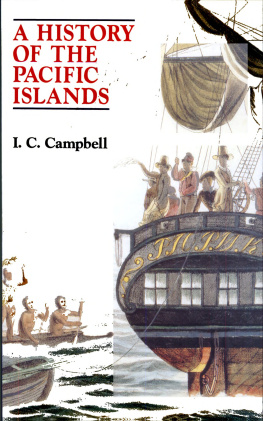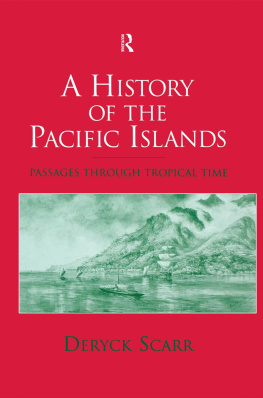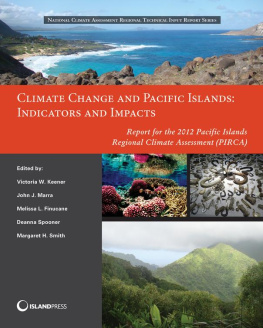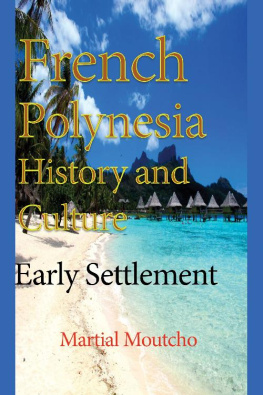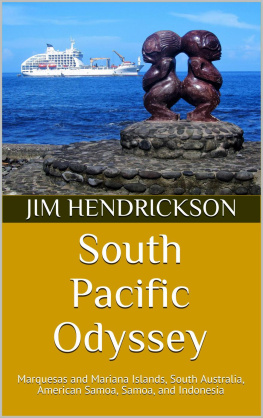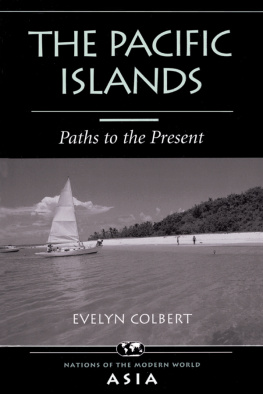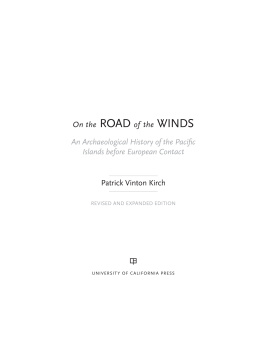I. C. Campbell - A History of the Pacific Islands
Here you can read online I. C. Campbell - A History of the Pacific Islands full text of the book (entire story) in english for free. Download pdf and epub, get meaning, cover and reviews about this ebook. year: 1989, publisher: University of Canterbury Press, genre: Politics. Description of the work, (preface) as well as reviews are available. Best literature library LitArk.com created for fans of good reading and offers a wide selection of genres:
Romance novel
Science fiction
Adventure
Detective
Science
History
Home and family
Prose
Art
Politics
Computer
Non-fiction
Religion
Business
Children
Humor
Choose a favorite category and find really read worthwhile books. Enjoy immersion in the world of imagination, feel the emotions of the characters or learn something new for yourself, make an fascinating discovery.
- Book:A History of the Pacific Islands
- Author:
- Publisher:University of Canterbury Press
- Genre:
- Year:1989
- Rating:4 / 5
- Favourites:Add to favourites
- Your mark:
- 80
- 1
- 2
- 3
- 4
- 5
A History of the Pacific Islands: summary, description and annotation
We offer to read an annotation, description, summary or preface (depends on what the author of the book "A History of the Pacific Islands" wrote himself). If you haven't found the necessary information about the book — write in the comments, we will try to find it.
A History of the Pacific Islands — read online for free the complete book (whole text) full work
Below is the text of the book, divided by pages. System saving the place of the last page read, allows you to conveniently read the book "A History of the Pacific Islands" online for free, without having to search again every time where you left off. Put a bookmark, and you can go to the page where you finished reading at any time.
Font size:
Interval:
Bookmark:
I. C. CAMPBELL
University of Canterbury Press Christchurch, New Zealand 1989
1989 I. C. Campbell
University of Canterbury Press Christchurch, New Zealand
Editor: Margaret Burrell
This book is copyright. Apart from any fair dealing for the purposes of private study, research, criticism or review, no part whatsoever may be reproduced by any process without the express written permission of the author and the University of Canterbury Press.
ISBN 0-908812-02-7 hardback 0-908812-03-5 paperback
Typographic design: | The Caxton Press, Christchurch, |
New Zealand | |
Cover design: | Max Hailstone |
Cartographer: | Tony Shatford |
Printed by: | Kyodo-Shing Loong |
Singapore |
Vowels In the writing of all Pacific island languages, each vowel is pronounced separately, and each has only one sound, unlike in English where a single vowel either by itself or in combination has a variety of possible sounds. There are, however, diphthongs which most English-speakers find difficult to reproduce exactly. These are the approximate equivalents:
a = ah | ai = long i |
e = eh | ae = long i |
i = ee | ei = long a |
o = aw | oe = oy |
u = oo | ou = long o |
au = ow (as in cow) |
Consonants
All consonants are as in English although g is always hard. Fijian and Samoan have some spelling peculiarities: in Samoan g is always pronounced as ng, and in Fijian the following substitutions need to be made by the reader:
b = mb | q = ngg (finger) |
d = nd | c = th |
g = ng |
The glottal stop (as in alii) is an unvoiced consonant made by a momentary stopping of the breath in the throat.
The Pacific Ocean, approximately one third of the earths surface, is the setting for a world of islands which were originally occupied by people who achieved the greatest feats of maritime navigation in all human history. Their colonization of this vast expanse was spread over several thousand years, during which time their cultures developed and diversified into a collection of intricate patterns. Their cultures were not only pragmatic systems of survival, but were also rich in imaginative power and beauty, representing achievements of the human mind, tongue and hand as inspiring as any others in the world.
These diverse peoples, broadly classified as Polynesian, Melanesian and Micronesian, had only desultory contact with Europeans in the sixteenth and seventeenth centuries, with regular systems of contact not becoming established until late in the eighteenth century. Over the next two hundred years, a succession of Europeans representing different facets of European civilization came to the islands, and left an indelible imprint of such objects and ideas as metals, Christianity, disease, medicine, literacy, individualism, money, the state, democracy, and justice.
The islands, their peoples and cultures were changed by their contacts with Europe, and although all relations between islanders and outsiders involved two-way traffic, cultural change has mostly been in one direction only.
By the beginning of the twentieth century all Pacific islanders had come at least nominally under the rule of western powers. Some of them (New Zealand Maoris and Hawaiians) had become citizens of the colonizing power. The history of colonialism in the Pacific islands shared some of the abuses of human rights common to colonialism elsewhere, but the comparative poverty of exploitable resources liberated colonial regimes from the temptation or necessity to be oppressive. Although there were ugly features of the colonial period of Pacific history, there were also cases of pragmatic moderation and of sincere and effective humanitarian administration.
After the Second World War political change was initiated in most Pacific island territories, with the result that since 1962 most of them have become independent nations. This transition has occurred sometimes earlier and faster than the inhabitants wished, when western ideology has proven a more important factor than island nationalism. The new nations of the Pacific islands, however, have found that political independence has not enabled them to meet all the social and economic goals which they optimistically envisaged. The desire for progress beyond the means of their own resources has induced a dependency and an accelerated rate of social change far greater than during the colonial era before 1950.
The historical literature of the Pacific islands is enormous, possibly greater in relation to population size than any other part of the world. Despite the enormous advances in knowledge of the area in recent decades, this book is the first since 1951 to present a synoptic history of the region as a whole. The book is therefore intended to be an introduction, to make more accessible to a wider and non-specialized readership the richness of the many specialized works on the subject. For that reason, and in deference to the purse or wallet of the reader, references have not been included. The table of further reading at the end of the book lists, without attempting to be comprehensive, a sample of books chosen for being most easily obtainable, or most authoritative. These scholarly works in turn all have extensive bibliographies, which any reader wanting further clarification may consult.
THE ORIGINAL INHABITANTS
When European voyagers first sailed into the Pacific Ocean in the nineteenth century they marvelled at finding populated islands. Subsequent visitors have marvelled at their inhabitants; they have admired the Polynesians for their beauty and stature, their wellordered communities, their open-handed friendliness, and for the homogeneity of culture, race and language which shows that this people was the most widely dispersed race on earth. Their neighbours to the west, the Melanesians, have also excited wonder: the people exhibit a unique diversity, with 1200 distinct languages (perhaps a quarter of the worlds total), cultures so different from each other and from cultures elsewhere that anthropologists have been baffled in their attempts to classify them. These people, less dispersed than the Polynesians, occupy a string of island chains which curve from New Guinea to New Caledonia like an arm protecting the Australian continent. North of the equator, the Micronesians remain for most people the unknown islanders, their homes the myriad sandy atolls which, known simply as the islands, form the inspiration of cartoonists and novelists. The Micronesians, like the Polynesians, are spread across a vast area of featureless ocean, and for people so far-flung, display a remarkable homogeneity.
To their earliest European visitors of the sixteenth, seventeenth and eighteenth centuries, these peoples were a double enigma. How could peoples with a strictly limited technology have found and populated such tiny, distant pieces of land? And having colonized these places, why were the most far-flung so much alike, and those most concentrated, so diverse?
To the common-sense mind of continental Europeans, differences of culture and language over distance were to be expected, and roughly speaking, the degree of difference was proportional to distance. Similar peoples lived nearest each other, dissimilar ones furthest away, for that is the cultural pattern of Europe. Similarly, to continental minds, dispersal was achieved by crossing land. When the first tentative maritime explorers had ventured into the Atlantic in the fifteenth century, they found islands which were uninhabited because they were out of sight and reach of a mainland. The natural conclusion to draw was that voyaging necessitated stout ships, extensive preparations, metal compasses and a way of measuring in clear night skies the elevation of the Pole Star.
Font size:
Interval:
Bookmark:
Similar books «A History of the Pacific Islands»
Look at similar books to A History of the Pacific Islands. We have selected literature similar in name and meaning in the hope of providing readers with more options to find new, interesting, not yet read works.
Discussion, reviews of the book A History of the Pacific Islands and just readers' own opinions. Leave your comments, write what you think about the work, its meaning or the main characters. Specify what exactly you liked and what you didn't like, and why you think so.

